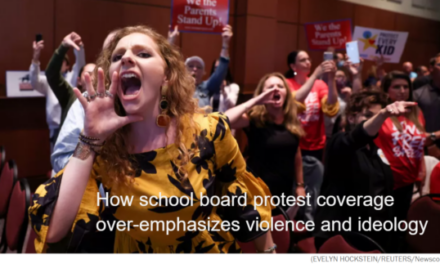In this week’s newsletter: School districts and educators are reconsidering their reading programs. Well-intended “mandatory reporting” requirements generate a flood of unfounded child abuse claims from educators. A journalist with rural roots explains how reporters get the rural higher ed story wrong — and how they can do better. A Mandarin preschool in Oregon helps its students and their community preserve their culture. And an education journalist makes a sharp observation about a recent feel-good story from the Washington Post.
TACKLING LITERACY
The big story of the week, according to us
Literacy is becoming a top priority for educators and many education journalists. Test scores are showing declines in many places, with English language learners hit particularly hard. But more and more schools are reconsidering their approach and trying new ones that may be more effective — often including phonics. And more and more journalists are tackling the topic:
🔊 In Mississippi, a Broad Effort to Improve Literacy Is Yielding Results (New York Times)
🔊 Leading dyslexia treatment isn’t a magic bullet, studies find, while other options show promise (Hechinger Report)
🔊 Early literacy screening a ‘starting point’ for educators (Boston Globe)
🔊 The youngest readers tackle sounds, words and the science of reading (EdSource)
🔊 Coalition says ‘science of reading-aligned’ core curricula barely used in California (EdSource)
🔊 Librarians want to help combat Indiana’s declining literacy rate (WFYI)
🔊 Sold a Story (APM Reports trailer)
Other big stories this week: There were a few important stories about safety threats to students outside of school buildings, including pedestrian crashes and a decline in crossing guards. And as false calls about active school shooters rise, several schools in South Florida were put on lockdown for what turned out to be hoaxes.

CHILD ABUSE REPORTS GONE WRONG
The best education journalism of the week, according to us
🏆 BEST: The best story of the week is Educators’ ‘Careless’ Child Abuse Reports Devastate Thousands of NYC Families by Asher Lehrer-Small in The 74. As mandated reporters, teachers are obligated to make a report to child welfare agencies if they think a kid is being abused, which often triggers a home visit from child protective services. But as Lehrer-Small reveals, it’s not easy for many college-educated, middle-class teachers to differentiate child abuse from the effects of poverty. In New York City, more than half the calls from teachers, guidance counselors, and principals turn out to be unfounded. The result is unnecessary intrusion and trauma for many families. “My children are happy-go-lucky kids and I’ve had to adultify them and tell them about the world much faster than I wanted to,” said one parent who was investigated after a false report her kids were malnourished. Published late last week, the story spotlights a topic that more education reporters should take on in the future.
See also: Mandatory reporting was supposed to stop severe child abuse. It punishes poor families instead. (NBC/ProPublica)
🏆 RUNNER-UP: This week’s runner-up is Why aren’t more Latino students enrolled in their states’ flagship universities? by Suzanne Gamboa for NBC News. This is a great accountability story about the racial mismatch between high school graduates and college enrollments. At CU Boulder, for instance, 14% of full-time 2020 freshmen were Latino, compared to 31% of Colorado’s high school graduates that year. The reasons for the gap include the high cost of tuition, insufficient scholarship money, the school’s reputation among Latinos as a “white” institution, and a lack of partnerships between the university and diverse districts like Denver. “I don’t know if the typical Denver student is who they want to target,” said the principal of a high school in heavily Latino southwest Denver. While the story focuses on Colorado and CU Boulder, California, Texas, and Nevada also have wide gaps between Latino high school graduates and enrolled students at the state universities.
See also: Spanish was the home language for more than 75% of English-language learners and 7.9% of all students in public schools (USA Today)
BONUS STORIES:
🏆 Michigan tried to limit ‘barbaric’ practice in 2016. Educators used it 94,000 times since. (Detroit Free Press)
🏆 A New Teacher at 50: Inside the Struggle to Rebuild America’s Black Teaching Workforce (EdWeek)
🏆 These Foster Kids Need Mental Health Care. New Mexico Is Putting Them in Homeless Shelters. (Searchlight New Mexico)
🏆 Robots Are Helping Immunocompromised Kids ‘Go to School’ (Wired)
🏆 Get to know the school lunch puzzle — and the workers who solve it each day (Fayetteville Observer)
RECONSIDERING RURAL HIGHER ED
New commentary from The Grade
You’re probably not covering rural higher education enough, or doing it wrong, writes Open Campus rural higher education reporter Nick Fouriezos.
Too many journalists focus on themes of scarcity, addiction, or backwardness, or write about rural communities as if they are homogeneous.
“It’s time for education reporters to leave behind assumptions made with closed eyes,” he writes. But all is not lost.
Fouriezos has great ideas about helping reporters find strength, innovation, and diversity in rural American higher education — with examples of those who are showing how to do it right.
In honor of Erica Green’s new story about efforts to support kinship care — in which family members take custody of a child in foster care rather than strangers — here’s Colleen Connolly’s recent guide for education reporters about how to find and cover foster care stories.
Also, I was happy to participate in the Institute for Citizens and Scholars’ fellowship event in Chicago this week, talking about how to write skeptical but compelling stories about career and technical education. Hard to believe it, but this Columbia Journalism Review article I wrote about news coverage of schools came out seven years ago.
Follow @alexanderrusso for thought-provoking commentary on education journalism all day, every day.

PRESERVING CULTURE THROUGH EARLY ED
Promising innovations & signs of progress
💡 (Above) A Mandarin preschool in Oregon is helping Chinese immigrants preserve their culture through early education. (Oregonian)
💡 An alternative high school in Boston is helping more Black and Latino boys earn a diploma after not finding success at traditional schools. (Boston Globe)
💡 A new hired position at Berkeley Unified aims to make reporting sexual misconduct in high school less traumatic. (KQED)
💡 A new law in California gives more voice to students in foster care — and should help keep them in class. (Sacramento Bee)

PEOPLE, RESOURCES
Who’s doing what, going where
Above: Giulia Heyward, left, and Tracy Swartz, right, are taking new jobs — and leaving the education beat.
🔥 Career moves: Giulia Heyward, the former New York Times reporting fellow who started as the national education reporter at Capital B in April, is already onto her next gig: covering breaking news for NPR. And Tracy Swartz, who’s been at the Chicago Tribune for 15 years and covering education for the last year and a half, is joining the New York Post to write and edit features and entertainment news.
🔥 Congrats! The Ed Lab collaborative just put out a new group effort about states easing job requirements for teachers. EWA announced its 15th class of reporting fellows. And Clara Hemphill’s new book about gentrification and equality is coming out in March. You can pre-order it now.
🔥 Research & resources: A new study published in Educational Researcher says schools need $500 billion more than the $190 billion in ESSER and American Rescue Plan funds to recover from pandemic academic loss. Results from a survey by researchers at the University of Southern California (covered by the Washington Post, The 74, and EdWeek, with vastly different headlines) show that most Americans know very little about critical race theory and are divided by party lines over teaching LGBTQ issues. And lastly, want to learn how to better interview officials known to spout misinformation? Take it from Jon Stewart, who was praised by journalists for how he confronted lies from Arkansas’ attorney general about gender-affirming care.
🔥 Job openings: The Chicago Tribune is hiring two new education reporters to replace Tracy Swartz on the Chicago Public Schools beat and Karen Ann Cullotta, whom we also hear is leaving, on the suburban education beat. The Pittsburgh Post-Gazette is also hiring a suburban education reporter. And the Hechinger Report is still looking for an engagement editor. The deadline to apply is Nov. 7.

PODCASTS, EVENTS
What’s happening and new research
Above: If you haven’t seen it already, take a look at the New Yorker’s beautiful and heartbreaking photo essay, Waiting for the School Bus in Uvalde, by Greg Miller.
⏰ Segments & podcasts: Oregon Public Broadcasting journalists have been following a group of students from the class of 2025 since they entered kindergarten, and a new video follows them during their freshman year of high school. Last week’s This American Life included a segment about the middle school boys at a Rhode Island school who tracked their teacher’s creepy behavior — a story originally reported by the Boston Globe’s Amanda Milkovits. ProPublica children and family reporter (and former Texas Tribune education reporter) Aliyya Swaby was on the PBS NewsHour talking about her reporting with Annie Waldman on laws targeting assistance for voters who struggle to read. And the AP’s Chrissie Thompson and AL.com’s Rebecca Griesbach appeared on a Twitter space event about teacher shortages.
⏰ More events: New America and the Washington Monthly hosted an event Wednesday on what colleges can do for their communities and the country. The Houston Chronicle’s Hannah Dellinger and Alejandro Serrano (now at the Texas Tribune) were on EWA Radio talking about their investigation into book banning efforts in Texas. The Hechinger Report’s Tara García Mathewson moderated a webinar on how to measure tutoring success. And last week’s EWA Radio included a brief but interesting discussion between Kavitha Cardoza and Anya Kamenetz about what role education reporters could have played in covering the pandemic. Skip to the 8:30 mark.
⏰ Coming soon: There’s a webinar later today on how new BIPOC hires and their managers can maximize the first 90 days on the job. EWA is hosting a reporter-focused webinar on Oct. 18 on how to better cover “The Nation’s Report Card.” IRE is hosting its second annual diversity, belonging, equity, and inclusion symposium Oct. 20-21.
THE KICKER

“This is a lovely, feel-good story and these kids deserve all the support that they get,” tweeted the Hechinger Report’s Christina Samuels. “But…I can’t help but reflect that all the cheering neighbors will support this high school band in any way OTHER than sending their children to this school.”
That’s all, folks. Thanks for reading!
Reply to this email to send us questions, comments or tips. Know someone else who should be reading Best of the Week? Send them this link to sign up.
Using Feedly or FlipBoard or any other kind of news reader? You can subscribe to The Grade’s “feed” by plugging in this web address: http://www.kappanonline.org/category/the-grade/feed/.
Read more about The Grade here. You can read all the back issues of The Grade’s newsletter, Best of the Week, here.
By Alexander Russo with additional writing from Colleen Connolly.
ABOUT THE AUTHOR

Alexander Russo
Alexander Russo is founder and editor of The Grade, an award-winning effort to help improve media coverage of education issues. He’s also a Spencer Education Journalism Fellowship winner and a book author. You can reach him at @alexanderrusso.
Visit their website at: https://the-grade.org/














